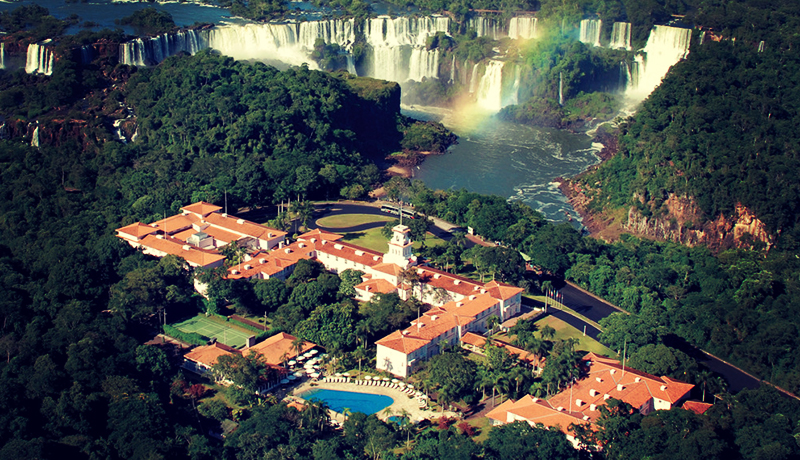
Soaring 260 feet at their highest point, comprising 275 individual falls (or cataratas, if you’re brushing up on your Spanish) and set amid a lush rainforest that’s home to more than 2,000 plant species and 400 types of birds, Iguassu Falls is among the world’s most astounding natural wonders.
The falls span the border between Argentina and Brazil in a forested pocket far from the countries’ glamorous big cities, a setting that makes the voyage there all the more worthwhile. Considering its unique location and microclimate, however, arriving at Iguazu Falls with a bit of insight will make for the most enjoyable — and unforgettable — visit.
Choose a side
Iguassu Falls makes its home in a pair of national parks — Iguazu in Argentina and Iguassu in Brazil. A stay on either side of the border delivers a different experience. From the Brazilian side is where you’ll enjoy the best panoramic views, but a stay on the Argentine side of the border will bring you face to face with the falls. There, a well-planned trail system takes you along the falls’ upper, middle and lower levels, putting their immense size and power on full display.
On the Brazilian side, check in at Forbes Travel Guide Four-Star Belmond Hotel das Cataratas. It’s the only hotel located inside Iguassu National Park, and some guest rooms offer views of the falls. On the Argentine side, stay at the Iguazú Grand Resort, Spa & Casino, a 15-minute drive from Iguazu National Park. You can’t see the falls from the property, but you can relax by its indoor and outdoor pools, sample spa treatments and feast on traditional Argentine asado (barbecue).
Know each country’s entry requirements
Hopping across the border to experience the falls from both sides might sound simple. And while it is possible, it requires some extra planning, especially if you’re staying on the Argentina side. To enter Brazil, U.S. passport holders are required to procure a tourist visa, which can be a time-consuming process.
What that means: If you’re staying in Argentina and want to cross into Brazil, you’ll be required to present a visa, making it all but impossible to head there on a whim. However, if you’re staying in Brazil, you can cross into Argentina and back with no extra effort.
Arrive early to avoid the rush
Regardless of which national park you plan to visit, arrive as early as possible — before the gates open, if you can — to avoid a tourist crush. On the Argentina side, your park visit begins with the Rainforest Ecological Train ride into the rain forest and to the start of the trail system.
Long lines on the boarding platform, crowded observation decks and slow-moving foot traffic on the trails can dial up the frustration factor of an otherwise Zen experience. Argentina’s park is open from 8 a.m. until 6 p.m.; hours for the Brazilian park are 9 a.m. until 5 p.m.
Seek a different perspective
Viewing the falls from the parks’ decks and trails is exhilarating enough, but seeing them from the air or the lower Iguazú River brings them to life in a whole new way. Visitors to the Brazilian side of the border can climb onboard a helicopter (Helisul is a popular provider) for a 10-minute aerial tour and million-dollar photo ops.
Helicopter tours are exciting, but they’re a polarizing topic: Although the flights afford unparalleled views of the falls, Iguazú’s national parks are also nature reserves, and helicopter activity disrupts their delicate ecosystems — so much so that flights aren’t offered on the Argentina side.

The Fabulous Falls, Photo Courtesy of ©iStock- mytrade1
For the most up-close experience imaginable, a boat ride into the bottom of the falls can’t be beat. Reputable operators like Brazil’s Macuco Safari and Argentina’s Iguazu Jungle take passengers on thrill rides into the churning white waters at the base of the falls, then cruise along a quieter passage to their end points, just upriver.
Waterproof whatever you can
Iguassu Falls was named for the Guarani word meaning “big water” and it’s for good reason: It’s everywhere. To what depths depends on how adventurous you are, but understand that getting wet is all but guaranteed. And that’s especially true on the Argentina side.
Have fun and go with the flow, but bring reinforcements just in case: resealable plastic bags for smartphones and cameras; sturdy, hooded ponchos; and a change of clothes to put on before heading back to your hotel. (Waterproof carry-on bags are issued to boat passengers before boarding.)
Whether you pass through a refreshing patch of mist while walking along the trails, get soaked by spray at the foot of the falls or drenched in a sudden downpour, you’ll be prepared.


